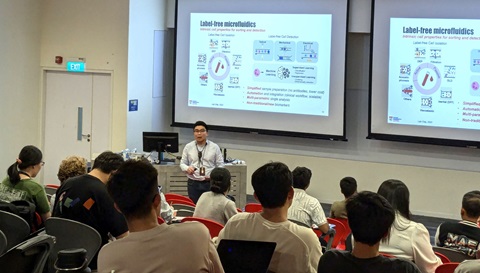Next Generation Solar Cells: Which One Will Win the Race? by Prof Wang Hongxia
IAS STEM Graduate Colloquium Jointly Organised with the Graduate Students' Clubs
The IAS and the Graduate Students’ Clubs of MAE, MSE, and SPMS jointly organised the STEM Graduate Colloquium Webinar featuring Prof Wang Hongxia from Queensland University of Technology on 28 March 2024.
Prof Wang currently serves as a theme leader of two research centres at the Queensland University of Technology, Australia – the Centre for Materials Science and the Centre for Clean Energy Technology and Practice. Her research primarily focuses on developing innovative approaches to enhance the performance and stability of third-generation solar cells and energy storage devices. To date, she has authored over 190 peer-reviewed scientific articles, two book chapters, and hold four patents in the field of energy materials and applications.

She first introduced how developing affordable renewable energy technologies to meet the rising global demand for clean energy is one of the biggest challenges of the 21st centenary according to various credible sources. Photovoltaics (PV) technology, which harnesses sunlight to generate electricity, is rapidly growing within the renewable energy market due to its potential to hopefully replace other harmful energy sources.
After addressing how photovoltaics technology works and its achievable theoretical efficiency limit, Prof Wang led us through the evolution of first-generation solar cells, which are based on silicon, to the third-generation solar cells, which are based on perovskite. This improvement has positioned PV technology as the top source of renewable energy in the global electricity generation when compared to other renewable energy sources like wind or water. Furthermore, perovskite PV technology stands out as the most promising among various types, demonstrated by its rapid improvement in efficiency over years of research. This technology boasts strong light absorption with tunability, along with an easy processing technique.
However, for the large-scale application or commercialisation of PV technology to be successful, it is important to consider the cost, lifetime, efficiency, and environmental impact. The emerging PV technologies are facing challenges related to poor stability and toxicity arising from the materials used. As a result, several researchers are currently concentrating on resolving these issues. Prof Wang showed a few examples that involved improving the stability through doping with additional constituents or coating (e.g. with functionalised carbon dots). To address the cost-effectiveness, she demonstrated that the gold electrodes can be replaced with carbon-based ones while retaining the efficiency.
 Interactive webinar by Prof Wang Hongxia on the solar cells
Interactive webinar by Prof Wang Hongxia on the solar cells
Furthermore, another challenge that researchers in this field aim to address is the use of harmful solvents in the fabrication process of these PV technologies. The perovskites within the solar cells are based on metal halides that typically dissolve in hazardous solvents like DMF and DMSO before further fabrication through solution-processing techniques. Prof Wang demonstrated the utilisation of green solvents such as ionic liquids and even water for the synthesis of PV. However, further research in this specific area is still necessary.
The audience greatly enjoyed the webinar and Prof Wang spent time answering every question, which mostly revolved around the environmental impact of these PV technologies such as recyclability. There were also questions related to the efficiency, optimisation, and limitations of the emerging perovskite photovoltaics technologies, as well as the incorporation of batteries for energy storage.
Written by Sapasakulvanit Slocha | NTU School of Mechanical and Aerospace Engineering Graduate Students' Club
“Prof Wang explained very clearly the working principle and challenges of current solar cells. She also shared with us how to overcome these challenges based on the work done by her students.” - Lim Jian Tiong (PhD Student, MAE)
“I enjoyed hearing her opinions on the scalability of solar cells, and the best solvent to use for manufacturing.” - Teresa Lim Yu Ping (PhD Student, IGP ERI@N)
“I found the information regarding the use of green solvent very useful, as well as the future perspectives given by Prof Wang.” - Neo Chun Siong (PhD Student, MSE)
“Very informative, and also quite suited to participants not well-versed in the topic” – Reuben Foo (PhD Student, CCEB)















/enri-thumbnails/careeropportunities1f0caf1c-a12d-479c-be7c-3c04e085c617.tmb-mega-menu.jpg?Culture=en&sfvrsn=d7261e3b_1)

/cradle-thumbnails/research-capabilities1516d0ba63aa44f0b4ee77a8c05263b2.tmb-mega-menu.jpg?Culture=en&sfvrsn=1bc94f8_1)






